Butter Makes Everything Better
Have you ever taken stock in the butter aisle, noticing all of the different varieties available? You head there with tunnel vision, after that same type of butter you always use, but notice the refrigerated section spans a pretty substantial space. Still, you throw your usual in the cart and carry on. But what are you leaving behind? What's the difference between those on the shelf and the one in your cart?
From Irish butter to ghee, there are tons of different types of butters out there, all with different recommended uses. Consider this your guide to all the different types — your butter bible, if you will.
























